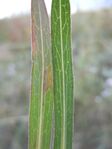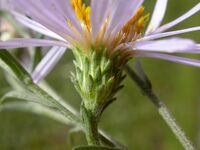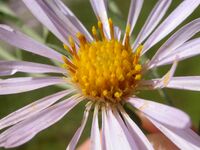Biology:Symphyotrichum ascendens
| Symphyotrichum ascendens | |
|---|---|
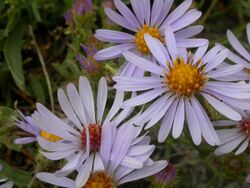
| |
| Symphyotrichum ascendes | |
| Scientific classification | |
| Kingdom: | Plantae |
| Clade: | Tracheophytes |
| Clade: | Angiosperms |
| Clade: | Eudicots |
| Clade: | Asterids |
| Order: | Asterales |
| Family: | Asteraceae |
| Tribe: | Astereae |
| Subtribe: | Symphyotrichinae |
| Genus: | Symphyotrichum |
| Subgenus: | Symphyotrichum subg. Ascendentes |
| Species: | S. ascendens
|
| Binomial name | |
| Symphyotrichum ascendens | |
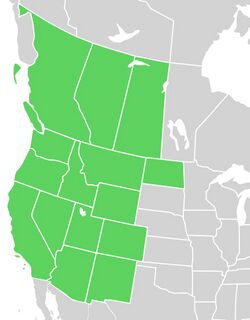
| |
| Native distribution by state and province[1] | |
| Synonyms[1] | |
|
Basionym
Alphabetical list
| |
Symphyotrichum ascendens (formerly Aster ascendens) is a species of flowering plant in the family Asteraceae known by the common names western aster,[2] long-leaved aster,[3] and Rocky Mountain aster.[4] Blooming July–September, it is native to western North America and can be found at elevations of 500–3,200 m (1,600–10,500 ft) in several habitats.
Description
Symphyotrichum ascendens is a rhizomatous, perennial, and herbaceous plant growing a branching, erect stem to heights between 20 and 60 centimeters (8 and 24 inches). Leaves are widely lance-shaped to oblong and pointed, the largest ones near the base of the stem reaching up to 15 cm (6 in) long. The stem and leaves are roughly hairy in places.[5]
The inflorescence is an array of many flower heads with many narrow violet to nearly white ray florets around a center of golden disc florets that open July–September.[6] The fruit is a hairy cypsela with a long pappus.[5] S. ascendens is similar to Symphyotrichum chilense, which has smaller flower heads.[4]
Chromosomes
Symphyotrichum ascendens has a chromosome base number of x = 13.[7] There are diploid individuals (2n = 26) which occur in the western portion of its range, and tetraploid ones (2n = 52) found eastward.[8]
Taxonomy
S. ascendens is a member of the genus Symphyotrichum, sometimes called American-asters,[9] classified in the subgenus Ascendentes.[7] Its basionym (original scientific name) is Aster ascendens Lindl., and it has many taxonomic synonyms. Its name with author citations is Symphyotrichum ascendens (Lindl.) G.L.Nesom.[1] In 1834, English botanist John Lindley formally described the plant that now is named Symphyotrichum ascendens.[10]
This species is allopolyploid, derived from the hybridization of S. spathulatum (chromosome base number x = 8) with S. falcatum (x = 5),[5] each from a different subgenus, Symphyotrichum and Virgulus, respectively.[11] This produced a plant with a unique base number of x = 13,[7] also written x2 = 13 (8 + 5),[8] and it warranted its own subgenus, Ascendentes, and its own species name. One other species is placed within subgenus Ascendentes: S. defoliatum.[11]
Distribution and habitat
Western aster is native to western North America from British Columbia to Saskatchewan, south to the United States in Montana and North Dakota then south to New Mexico, west to California , north to Washington (state) , and all states in between.[1] It can be found at elevations of 500–3,200 meters (1,600–10,500 feet) in several habitats including grasslands, sagebrush steppe, and meadows.[5]
Citations
- ↑ 1.0 1.1 1.2 1.3 1.4 POWO 2021.
- ↑ USDA, NRCS 2014.
- ↑ BSBI 2007.
- ↑ 4.0 4.1 Taylor 1992, p. 134.
- ↑ 5.0 5.1 5.2 5.3 Brouillet et al. 2006.
- ↑ Allen 2012.
- ↑ 7.0 7.1 7.2 Semple 2021.
- ↑ 8.0 8.1 Semple n.d.a.
- ↑ Native Plant Trust 2021.
- ↑ IPNI 2021.
- ↑ 11.0 11.1 Semple n.d.b.
References
- Template:Cite Jepson eFlora
- Flora of North America Editorial Committee, ed. (2006), "Symphyotrichum ascendens", Flora of North America North of Mexico (FNA), 20, New York and Oxford, http://www.efloras.org/florataxon.aspx?flora_id=1&taxon_id=250067626, retrieved 22 July 2021
- Template:Cite BSBI 2007
- "Aster ascendens Lindl., Fl. Bor.-Amer. (Hooker) 2(7): 8 (1834)". International Plant Names Index (IPNI). Royal Botanic Gardens, Kew. https://www.ipni.org/n/272803-2.
- "Symphyotrichum (American-aster): Go Botany". Framingham, Massachusetts: Native Plant Trust. 2021. https://gobotany.nativeplanttrust.org/genus/symphyotrichum/.
- "Symphyotrichum ascendens Western Aster". Arlington, Virginia: NatureServe. 2 July 2021. https://explorer.natureserve.org/Taxon/ELEMENT_GLOBAL.2.131605/Symphyotrichum_ascendens.
- POWO (2021). "Symphyotrichum ascendens (Lindl.) G.L.Nesom" (in en). Royal Botanic Gardens, Kew. http://www.plantsoftheworldonline.org/taxon/981773-1.
- "Symphyotrichum ascendens x" (in en). Ontario. n.d.a. https://uwaterloo.ca/astereae-lab/research/asters/symphyotrichum/symphyotrichum-subg-ascendentes/symphyotrichum-ascendens-x.
- "Symphyotrichum subg. Ascendentes" (in en). Ontario. n.d.b. https://uwaterloo.ca/astereae-lab/research/asters/symphyotrichum/symphyotrichum-subg-ascendentes.
- "Symphyotrichum ascendens — Long-leaved Aster, Intermountain Aster, Western Aster" (in en). Ontario. 14 May 2021. https://uwaterloo.ca/astereae-lab/symphyotrichum-ascendens.
- Taylor, Ronald J. (1992) (in en). Sagebrush Country: A Wildflower Sanctuary. Missoula, Montana: Mountain Press Publishing Company. ISBN 0-87842-280-3. OCLC 1036858077. https://archive.org/details/sagebrushcountry00tayl/. Retrieved 20 January 2022.
- "Symphyotrichum ascendens". Natural Resources Conservation Service PLANTS Database. USDA. 2014. https://plants.usda.gov/core/profile?symbol=SYAS3.
External links
- BONAP distribution map, Biota of North America Program, 2014
Wikidata ☰ {{{from}}} entry
 |

